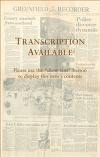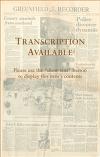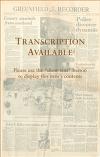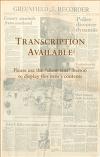|

"Quakers Plan More Gifts for Vietnam War Victims" article in The Greenfield Recorder newspaper

"TFHS Students Share "A Day of Concern" article in The Greenfield Recorder newspaper

"UM Students Protest Move Into Cambodia" article in The Greenfield Recorder newspaper

"War Protest Keeps New England College Campuses in Ferment" article in The Greenfield Recorder newspaper
|
Summary and Objective
Students will understand that local communities took part in anti-war protests during the Vietnam War and that those actions were often in association with university students.
This lesson should be given only after studying aspects of the Vietnam War, including the peace movement that involved Sit-Ins, other forms of student protests, and militant responses to them such as in the Kent State Massacre.
Students will examine a given community and its involvement in the anti-war movement. Through analysis of primary documents students will examine some perspectives and actions taken by people in the Pioneer Valley of Massachusetts. The design for this lesson is focused upon Western Massachusetts. However, by changing the primary documents to those of another community teachers may adapt the lesson for his or her own region of the country. It may also be of interest to people in other parts of the country to examine the local events of another community. In the study of this topic students typically are given information on specific locations such as Chicago and San Francisco. However, these symbols of the era lack a local perspective that may be gained through analysis of local events.
Next step: This lesson focused upon the anti-war movement. To produce a more balanced perspective of local events, the teacher should create a similar lesson that focuses upon the pro-war support given by community members as well as the dislike/conflict with the anti-war protesters.
Teaching Plan
Step 1.
Prior to teaching this lesson students should have studied various aspects of the Vietnam War, including the Gulf of Tonkin Resolution, Cold War politics such as containment, the free election won by Ho Chi Minh and the US refusal to accept the results, and the treatment of monks and monasteries by US supported Diem. Students should also have viewed images of napalm and Agent Orange victims. Students will be provided with a balanced view of the Vietnam War. However, this particular lesson will support the local view of those who opposed the war and should be preceded by national evidence against the war in Vietnam.
Step 2.
Students will break into small groups for all of the following activities. Each group will have a recorder to take notes for the group, a facilitator to manage the group discussion, a task master to keep the group on time, and a reporter to share findings with the rest of the class.
Step 3.
Students will read aloud in their groups four examples of anti-war protests taken by people in the Pioneer Valley of MA during the Vietnam War. These include the following articles from the Greenfield Recorder: "TFHS Students Share A Day of Concern", "War Protest Keeps New England College Campuses in Ferment", "UM(University of MA) Students Protest Move Into Cambodia", and "Quakers Plan More Gifts for Vietnam War Victims."
Step 4.
After reading each, students will summarize the key points of the articles. They will write a summary paragraph that answers: "How did different groups gather to show their perspectives on the war in very different ways?" and "From previous lessons, what other means of protest were used to express (local) anti-war feelings?" Students reporters will share their views with the class, and findings will be posted on a board available in the classroom.
Step 5.
After all groups have reported, the teacher will write the following question on the board for students to answer: "In what ways are the Vietnam War anti-war actions different from actions of those opposing the war in Iraq?" Students will write for three minutes in their journals prior to any discussion. After students are given a chance to personally reflect, students will be asked to share their responses. The teacher or a student assigned to the task will write down ideas brought up by students. Students will then be asked to find three local news articles that reflect present-day anti-Iraq War protest in the Pioneer Valley, using a pc. These may be from any time during the war, but may only be local stories, not just national AP printed in a local paper. When finished, students will be given two questions for their groups to discuss: "How difficult was it to find the article and why do you think that it was easier or difficult?" and "How did these methods vary from the protest methods and studied in relation to the Vietnam War?" Students will discuss these questions within their groups before each of them writes his or her personal responses within a student journal.
Step 6.
Students will use their knowledge of the Vietnam and Iraq anti-war movements to create an anti-war poster that merges the two protest movements. Each student will be provided with an 11 by 17 or larger (preferably a standard size sheet of poster board) in which to create the product. Students may incorporate slogans, images, and their own interpretations of the conflicts to create a compelling argument against these wars, while trying identifying possible parallels between them. Students will finish this for homework. Posters will be presented next class prior to the following class which shows a contrast to the anti-war movement.
Step 7.
The next class will examine the support for the Vietnam War in the Pioneer Valley (or other location) by analyzing political cartoons, newspaper editorials, and news articles supportive of the war. This will in turn be compared with the current support for the war in Iraq.
|




